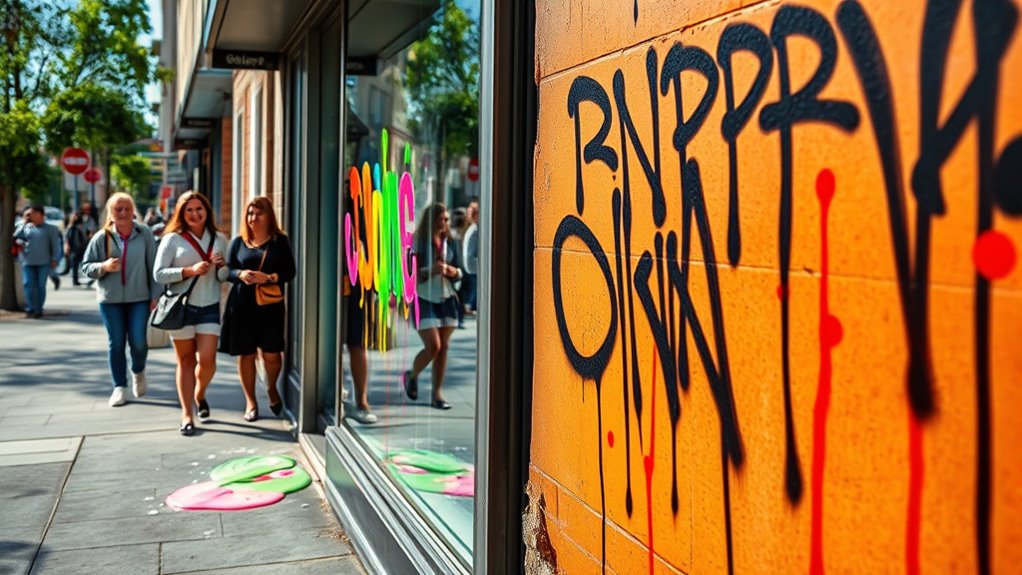Responsible pranking is all about keeping fun and harmlessness in mind. You should aim for lighthearted surprises that make people smile without causing damage, discomfort, or embarrassment. Avoid anything that might be considered vandalism, like property damage or trespassing. Respect others’ boundaries and seek permission when needed. If you stay mindful of these rules, you can create enjoyable moments while avoiding trouble—continuing will help you master the art of playful, respectful pranking.
Key Takeaways
- Responsible pranking is harmless, respectful, and avoids property damage or crossing legal boundaries.
- Fun pranks foster laughter and trust but should always consider others’ feelings and consent.
- Vandalism involves intentional property damage, defacement, or any act that causes harm or distress.
- Always obtain permission and stay within legal limits to differentiate responsible fun from vandalism.
- Recognize when a prank causes upset, embarrassment, or potential harm, and stop immediately.
Understanding the Difference Between Playful Pranks and Destructive Vandalism

While pranks can be fun, it’s important to recognize the line between harmless play and damaging vandalism. Understanding this difference involves considering ethical considerations, ensuring your prank doesn’t harm others or damage property. Respecting cultural sensitivities is also crucial; what might seem funny in one culture could offend or hurt in another. A playful prank should bring laughter without crossing boundaries or causing emotional or physical harm. Vandalism, on the other hand, intentionally damages or defaces property, often with malicious intent. Being aware of these distinctions helps you act responsibly and thoughtfully. Additionally, knowing about damage prevention techniques can help you plan pranks that stay within safe and respectful boundaries. By focusing on kindness and respect, you can enjoy pranking without risking negative consequences or offending community norms. This awareness keeps your pranks fun and harmless for everyone involved.
The Impact of Pranks on Friendships and Community Trust

Pranks can strengthen friendships when they’re lighthearted and received in good spirits, fostering shared laughter and trust. When done respectfully, they boost community bonds by creating memorable moments and shared experiences. However, if pranks go too far or are poorly timed, they risk trust erosion, damaging relationships and undermining the sense of safety within your community. Trust is delicate; once broken, it’s hard to repair. Responsible pranking requires awareness of boundaries and understanding your friends’ comfort levels. When you prioritize empathy and ensure your pranks are harmless fun, you help build stronger connections. Additionally, color accuracy in the execution of pranks—such as carefully choosing visuals or messages—can enhance their positive impact. Conversely, crossing lines can lead to feelings of betrayal and skepticism, weakening the very bonds you aim to strengthen through playful mischief.
Legal Boundaries: When Pranks Cross Into Illegal Territory

You need to understand that certain pranks can violate trespassing laws if you enter someone’s property without permission. Property damage can lead to serious legal consequences, even if your intentions were harmless. Additionally, pranks involving harassment or threats can cross into criminal behavior, risking fines or jail time. Be aware that engaging in illegal activities related to pranking can have lasting repercussions.
Trespassing Laws and Permissions
Understanding trespassing laws is essential before pulling any prank that involves entering private property. You need to know that trespassing laws vary by location, but generally, entering someone’s property without permission is illegal. Even if your intentions are harmless, you could face legal consequences if you don’t obtain the permissions required. Always seek explicit permission from property owners before sneaking onto their land or buildings. Respect private boundaries to avoid accusations of trespassing or vandalism. Remember, a prank that crosses into trespassing territory can quickly turn into a legal issue. It’s your responsibility to stay informed about local laws and ensure you have the necessary permissions required to avoid unintended trouble. Responsible pranking means respecting legal boundaries at all times. Additionally, understanding the effectiveness of eye patches can help you assess whether a prank involving cosmetic products might be suitable or not.
Property Damage Consequences
When planning a prank, it’s important to contemplate not just legal permissions but also the potential for property damage. Graffiti art, for example, can seem harmless but quickly becomes property vandalism if done without consent. Damaging property can lead to serious legal consequences, including fines and criminal charges. To illustrate, consider this table:
| Type of Damage | Example | Potential Penalty |
|---|---|---|
| Graffiti Art | Spray-painting walls | Fines, restitution |
| Property Vandalism | Breaking windows | Jail time, fines |
| Minor Damage | Scratched surfaces | Community service |
| Major Damage | Structural destruction | Felony charges |
| Vandalism in Public | Defacing park benches | Civil suit, fines |
Avoid crossing into illegal territory—respect property boundaries to prevent damaging others’ property.
Harassment and Threats
Pranks that involve harassment or threats can quickly cross legal boundaries and lead to serious consequences. Engaging in online harassment or making threatening gestures can be mistaken for bullying, risking criminal charges and permanent damage to your reputation. When you cross these lines, you may cause emotional distress, fear, and harm to others. It’s essential to prioritize bullying prevention and respect personal boundaries. Remember, what starts as a joke can escalate into:
- Legal action, including fines or jail time
- Damage to relationships and trust
- Emotional trauma for victims
- A lasting negative impact on your life
Always think about the impact of your actions and avoid behaviors that could be perceived as threatening or harmful. Responsible pranking is about fun, not causing harm or fear. Legal implications should always be considered before engaging in any prank that could be misinterpreted.
Tips for Planning Responsible and Respectful Pranks

When planning a prank, focus on ideas that are harmless and fun, ensuring no one gets hurt or upset. Always ask for permission from the person involved to avoid crossing boundaries or causing unintended stress. Respect and consideration are key to making your prank enjoyable for everyone involved. Additionally, understanding the importance of ethical considerations can help ensure that your prank remains responsible and respectful.
Choose Harmless Ideas
How can you guarantee your prank stays fun without crossing the line? Focus on choosing harmless ideas that avoid reinforcing prank stereotypes or causing genuine confusion. Aim for pranks that lead to humorous misunderstandings rather than embarrassing or upsetting others. Think playful rather than mean. To keep it light, consider ideas like swapping sugar with salt or placing googly eyes on objects. Make sure your prank:
- Doesn’t target someone’s personal belongings or reputation
- Is easy to undo and leaves no lasting mess
- Invokes laughter without hurt feelings
- Avoids tricking people into dangerous or uncomfortable situations
Understanding safe practices can help ensure your prank remains responsible and respectful.
Obtain Permission First
Before pulling off any prank, obtaining consent from the person involved or affected is vital. Consent essentials ensure everyone feels comfortable and respected, preventing misunderstandings or harm. Follow permission protocols by clearly communicating your intentions and gauging their comfort level. It’s best to ask directly, rather than assume, and respect their decision if they decline. Remember, responsible pranking isn’t about surprise at any cost—it’s about shared fun without crossing boundaries. If you’re unsure, discuss the prank beforehand or seek input to avoid causing stress or discomfort. Always prioritize respect and honesty, making sure everyone involved understands the nature of the prank and agrees to it. This approach keeps your prank fun, harmless, and considerate. Additionally, understanding air purifier maintenance dos and don’ts can help demonstrate responsible behavior in other areas of life.
Recognizing When a Prank Goes Too Far

Recognizing when a prank has crossed the line is essential to maintaining respect and safety. If the prank causes distress, embarrassment, or harm, it’s a sign you’ve gone too far. Remember, good prank etiquette emphasizes respecting boundaries and understanding the importance of consent. Pay attention to these warning signs:
- The target looks genuinely upset or angry
- The prank causes physical or emotional pain
- Someone feels humiliated or embarrassed afterward
- The situation escalates beyond playful fun
If any of these occur, stop immediately and apologize. Respecting others’ feelings and boundaries isn’t just polite—it’s necessary. A true prankster knows when to pull back and prioritize safety over a fleeting laugh. Always consider the impact before proceeding. For a more positive experience, incorporating elements of cooperative play can help ensure everyone enjoys the fun without crossing boundaries.
Creative Ideas for Safe and Fun Pranks

Creative pranks can bring fun and laughter without risking anyone’s well-being. To stay within humor boundaries, focus on harmless ideas that spark smiles. Prank creativity thrives when you choose playful scenarios that surprise without upsetting. For example, swapping sugar with salt or placing fake insects in unexpected spots keeps the prank lighthearted. Here’s a quick idea list:
| Lighthearted Pranks | Playful Surprises |
|---|---|
| Changing desktop backgrounds | Filling a room with balloons |
| Rearranging items on a desk | Fake spilled drink on floor |
| Switching cereal boxes | Fake “out of order” signs |
These ideas promote safe fun, ensuring everyone enjoys the humor without crossing boundaries. Additionally, understanding toxic insects can help prevent accidental exposure during outdoor pranks.
Encouraging Empathy and Consent in Pranking Activities

While playful pranks can spark joy, it’s important to prioritize empathy and consent to make certain everyone enjoys the fun. Building consent awareness helps you understand boundaries and ensures no one feels uncomfortable. To foster empathy development, consider how your prank might affect others emotionally. Remember, a thoughtful approach strengthens trust and keeps the environment positive. Keep these points in mind:
- Always ask for permission before pranking someone.
- Pay attention to their reactions to gauge comfort levels.
- Respect a person’s right to decline or stop the prank.
- Think about how you’d feel if roles were reversed.
- Recognizing emotional impact can help you assess the appropriateness of your prank.
Frequently Asked Questions
How Can I Tell if a Prank Is Appropriate for All Ages?
To tell if a prank is age-appropriate, consider the humor involved and whether it’s harmless fun. Ask yourself if it’s suitable for all ages, avoiding anything that might embarrass or hurt someone. If it’s light-hearted and inclusive, it’s likely appropriate. Think about the audience’s age and sensitivities, and when in doubt, opt for pranks that promote laughter without crossing boundaries or causing discomfort.
What Are Some Signs a Prank Might Be Considered Harassment?
If a prank shows bullying indicators like targeting someone repeatedly or making them uncomfortable, it might be harassment. Look for signs of lacking consent, such as the person feeling pressured or distressed afterward. If your prank causes harm or violates boundaries, it’s a clear sign you’re crossing into harassment. Always check if the person is willingly participating and feels safe; if not, reconsider your approach.
How Do Cultural Differences Impact Perceptions of Pranks?
Like a mosaic of different colors, cultural differences shape how you perceive pranks. You find that cross-cultural humor varies widely, influencing what’s seen as playful or offensive. Global prank norms aren’t universal; what’s funny in one culture might be disrespectful in another. By understanding these differences, you can avoid misunderstandings, ensuring your pranks are lighthearted rather than hurtful, respecting the diverse perspectives of those around you.
Can Pranking Be Used as a Form of Social Activism?
Yes, you can use pranking as social activism, but you must respect ethical boundaries and consider community impact. Pranks can raise awareness or challenge norms, but they shouldn’t harm or offend others. When planning a prank for activism, guarantee it promotes positive change and doesn’t cross lines into vandalism or hurtful behavior. Thoughtful pranks can spark conversations and inspire action without damaging relationships or communities.
How Should I Handle Remorse if My Prank Unintentionally Hurts Someone?
When your prank unintentionally hurts someone, you should first acknowledge their feelings with genuine empathy. Picture the hurt as a shadow cast by your actions. Use apology strategies like sincere words and listening actively. Reflect on how your prank affected them, then make amends. This process not only helps heal wounds but also develops your empathy, ensuring future pranks remain fun without crossing boundaries.
Conclusion
Remember, most people see around 2,000 pranks in a lifetime—so choose yours wisely. When you keep pranks playful and respectful, you’re more likely to build strong friendships and community trust. A harmless joke can brighten someone’s day, but crossing the line can damage relationships forever. Stay empathetic, seek consent, and aim for fun that everyone can enjoy. Responsible pranking creates memories, not regrets.










